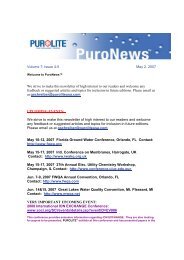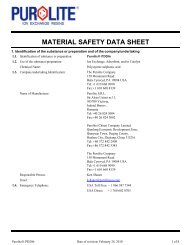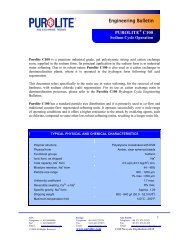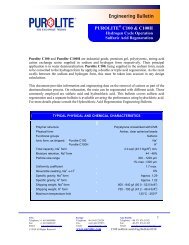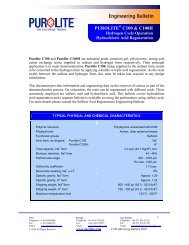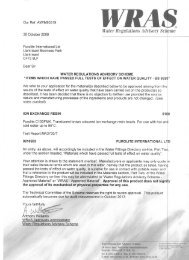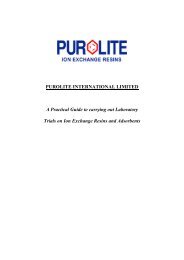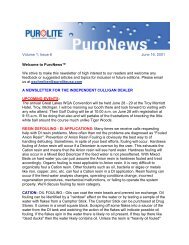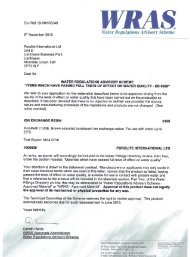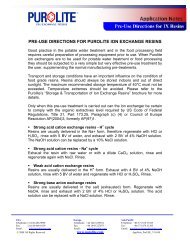Counter-flow regeneration - Purolite.com
Counter-flow regeneration - Purolite.com
Counter-flow regeneration - Purolite.com
Create successful ePaper yourself
Turn your PDF publications into a flip-book with our unique Google optimized e-Paper software.
<strong>Purolite</strong> A400 is an industrial grade, polystyrenic, gel, type 1 strong base anion exchange resin<br />
and is normally supplied in the chloride (salt - exhausted) form, but it is also available in the<br />
hydroxide (regenerated) form as <strong>Purolite</strong> A400OH. Its principal application is in water<br />
demineralization. Like all strong base anion resins the resin swells between the exhausted and<br />
the regenerated form and this must be taken into account in any design calculations. The data in<br />
this engineering bulletin is specific to <strong>Purolite</strong> A400 supplied in the chloride form.<br />
Strong base type 1 anion resins have a relatively, higher temperature resistance than other<br />
strong base anion resins when operated in the hydroxide form, and also offer very good silica<br />
removal with low silica leakage, even in co-<strong>flow</strong> regenerated plants. <strong>Purolite</strong> A400 is therefore<br />
widely encountered in anion units working in hot climates or other situations when warm water<br />
is encountered, e.g. where the raw water is preheated. Strong base resins of this type are also<br />
widely encountered all around the world as the anion <strong>com</strong>ponent of mixed beds.<br />
This document provides information and engineering data on the removal of anions as part of<br />
the demineralization process. On exhaustion, the resin can be regenerated with a dilute solution<br />
of sodium hydroxide.<br />
TYPICAL PHYSICAL AND CHEMICAL CHARACTERISTICS<br />
Polymer structure Polystyrene crosslinked with DVB<br />
Physical form Amber to pale yellow, clear spherical beads<br />
Functional groups Type 1 quaternary ammonium<br />
Ionic form, as shipped Chloride (Cl - )<br />
Total capacity, Cl - form 1.3 eq/l (28.4 Kgr/ft 3 ) min.<br />
Moisture retention, Cl - form 48 - 54%<br />
Particle size range 300 - 1200 µm<br />
1% max.
Available Grades<br />
<strong>Purolite</strong> A400 is also available in different grades supplied in the Cl - form, unless otherwise<br />
stated. Other ionic forms are also available in most grades and product data sheets with more<br />
detailed information on the products listed are available on our web site www.purolite.<strong>com</strong>.<br />
Single Bed Applications<br />
- <strong>Purolite</strong> A400 is a standard grade resin with a Gaussian particle size distribution in the<br />
range 300-1200 µm. Its principal application is in co-<strong>flow</strong> and traditional counter-<strong>flow</strong><br />
regenerated plants, where classification of the bed inside the operating vessel is possible.<br />
- <strong>Purolite</strong> A400C is a modified grade with a particle size in the range 425-1200 µm, used in<br />
high <strong>flow</strong> rate applications to reduce pressure drop across the bed.<br />
- Purofine PFA400 is a uniform particle size product with a mean particle size of 570±50<br />
µm and a UC of 1.1-1.2, offering improved performance with regard to capacity, leakage,<br />
pressure drop and rinse water volumes in co-<strong>flow</strong> and counter-<strong>flow</strong> engineering designs.<br />
- Puropack PPA400 is another uniform grade product, offering similar advantages, but with<br />
a mean particle size of 650±50 µm. This product has been specifically developed for the<br />
PUROPACK system and other packed bed designs employing either up-<strong>flow</strong> or down-<strong>flow</strong><br />
service operation. This resin is also widely used in co-<strong>flow</strong> and other counter-<strong>flow</strong><br />
engineering designs, employing split <strong>flow</strong>, air and water hold down, etc.<br />
- <strong>Purolite</strong> A400E is a specially cleaned, food grade version, for use in food processing.<br />
-<br />
Dual Layer (Stratified Bed) Applications<br />
- <strong>Purolite</strong> A400DL is a specially designed, coarse grade version of <strong>Purolite</strong> A400. Its<br />
principal application is in layered bed anion exchange units in conjunction with a DL grade<br />
<strong>Purolite</strong> weak base anion resin such as <strong>Purolite</strong> A100DL.<br />
Mixed Bed Applications<br />
Three grades of <strong>Purolite</strong> A400 are widely used in mixed beds. These are all specifically<br />
designed to separate well from the cation <strong>com</strong>ponents. All three grades are antistat treated to<br />
reduce the chances of clumping when first installed.<br />
- <strong>Purolite</strong> A400MB is a modified, simple mixed bed grade resin trimmed to give better<br />
separation than the standard grade product. It is usually used with gel mixed bed grade<br />
cation resins and is most often encountered in <strong>com</strong>bination with <strong>Purolite</strong> C100MB, <strong>Purolite</strong><br />
C100MBH, <strong>Purolite</strong> C100x10MB or <strong>Purolite</strong> C100x10MBH.<br />
- <strong>Purolite</strong> A400TL is a specially graded resin with a relatively fine particle size for use in<br />
TRILITE mixed bed systems, with or without intermediate inert. It is usually found in<br />
conjunction with a TL grade cation resin, such as <strong>Purolite</strong> C100TL, <strong>Purolite</strong> C100TLH,<br />
<strong>Purolite</strong> C100x10TL, and <strong>Purolite</strong> C100x10TLH. <strong>Purolite</strong> A400TL can be supplied in the<br />
sulphate form for easier conversion to the regenerated hydroxide form.<br />
- Purofine PFA400MB is a uniform particle size product, normally used in mixed bed<br />
applications. It is usually employed in conjunction with Puropack PPC100H.<br />
USA Europe Asia Pacific<br />
2<br />
Telephone: +1 610 6689090 Telephone: +44 1443 229334 Telephone: +86 571 876 31382<br />
Fax: +1 610 6688139 Fax: +44 1443 227073 Fax: +86 571 876 31385<br />
Email: info@puroliteusa.<strong>com</strong> Email: sales@purolite.<strong>com</strong> Email: info@purolitechina.<strong>com</strong><br />
© 2011 All Rights Reserved www.purolite.<strong>com</strong> A400_Eng Bull_31Mar2011
Typical Operating Data (Guide to Service Operation and Regeneration)<br />
Service Operation<br />
In the demineralization process, the anion column is always located downstream of the cation<br />
column, sometimes with a weak base anion unit and/or a degasser tower between the cation and<br />
strong base anion, depending on the raw water quality and plant design. The resin has to be<br />
downstream of the cation because calcium and magnesium ions must be removed prior to the<br />
anion bed. If not these ions will precipitate when in contact with anion resin in the hydroxide<br />
form, creating major operating problems and loss of performance.<br />
We suggest you read the <strong>Purolite</strong> A100 engineering bulletin to understand when weak base<br />
anion resins are employed prior to strong base anion resins.<br />
Where the raw water contains a significant amount of alkalinity (bicarbonate), degassing<br />
towers can be located after the cation column, prior to the strong base anion bed. Degassers<br />
allow a significant reduction of the ionic load on to the anion resin, therefore reducing the anion<br />
resin volume required and the amount of regenerant used, significantly reducing operating costs<br />
if the alkalinity loading is high. The exchange of the associated cations with H + ions, which<br />
takes place within the cation vessel, converts all bicarbonate to carbonic acid, and in the low<br />
pH conditions existing after the cation bed, carbonic acid dissociates into carbon dioxide and<br />
water. A degassing tower consists of a column filled with ceramic or plastic pall rings, in which<br />
the decationized water is sprayed on to the rings and <strong>flow</strong>s down through the packing, while a<br />
<strong>flow</strong> of low pressure air is blown into the bottom of the tower. The high contact surface<br />
between water and air created by the pall rings speeds up the migration of carbon dioxide<br />
dissolved in the water to the air, thus reducing the concentration of carbon dioxide in degassed<br />
water to or close to the solubility level. The degassed water is then collected in a sump for<br />
pumping through the next stage using dedicated pumps.<br />
In service operation decationized or decationized and degassed water is normally pumped<br />
through the anion resin bed, which is retained within a pressure vessel. The vessel has top and<br />
bottom distribution / collection systems. These systems are designed to ensure the water passes<br />
evenly through the ion exchange bed in service operation. As the water passes through the<br />
resin, the anions present (principally sulfate, nitrate, chloride, carbon dioxide, silica and any<br />
other dissolved anionic species) are exchanged with hydroxide ions. The pH of the anion<br />
treated water increases across the resin bed, from the acid to the slightly alkaline range, and at<br />
the same time the conductivity falls significantly. When the plants are working correctly, the<br />
conductivity at the exit of the anion column is dictated by the sodium leakage from the cation<br />
bed. When the anion resin is exhausted it is then regenerated with a sodium hydroxide solution<br />
to put the resin back into the regenerated hydroxide form, ready for the next service operation.<br />
It is important that the internal systems within the unit efficiently distribute and collect both the<br />
water during service operation and the regenerant solution, rinses, etc., during <strong>regeneration</strong>,<br />
especially since the regenerant and the slow rinse run at much lower <strong>flow</strong> rates than the service<br />
<strong>flow</strong> rate.<br />
USA Europe Asia Pacific<br />
3<br />
Telephone: +1 610 6689090 Telephone: +44 1443 229334 Telephone: +86 571 876 31382<br />
Fax: +1 610 6688139 Fax: +44 1443 227073 Fax: +86 571 876 31385<br />
Email: info@puroliteusa.<strong>com</strong> Email: sales@purolite.<strong>com</strong> Email: info@purolitechina.<strong>com</strong><br />
© 2011 All Rights Reserved www.purolite.<strong>com</strong> A400_Eng Bull_31Mar2011
In service operation optimum performance is achieved at service <strong>flow</strong> rates between 8 and 40<br />
BV/h (Bed Volumes per hour) or 1 to 5 gpm/ft 3 (US gallons per minute per cubic foot of resin),<br />
with linear <strong>flow</strong> rates (velocities) of 10 to 50 m 3 /m 2 /h (m/h) or 4 to 20 gpm/ft 2 (US gallons per<br />
minute per square foot of vessel cross-section), whereas caustic <strong>regeneration</strong> is carried out at<br />
<strong>flow</strong> rates of between 2 to 6 BV/h or 0.25 to 0.75 gpm/ft 3 . Within these limits internal<br />
distribution / collection systems can operate efficiently at both the higher service and lower<br />
regenerant <strong>flow</strong> rates. At very low service <strong>flow</strong> rates channelling can occur within the resin bed<br />
resulting in poor plant performance and short capacity between <strong>regeneration</strong>s. This is<br />
particularly likely when long service cycles are employed.<br />
The ratio of height to diameter is important in any ion exchange unit design. While some<br />
small industrial demineralization plants operate with very shallow bed depths, bed depths<br />
below 610 mm (2 ft) should be avoided and preferably bed depths greater than 1000 mm<br />
(3 ft 3 in) employed. Vessel height and pressure drop are normally the controlling factor on the<br />
maximum height of the bed. For <strong>Purolite</strong> A400 we re<strong>com</strong>mend that pressure drop across the<br />
bed should be maintained at less than 150 kPa (22 psi), having made allowance for bed<br />
<strong>com</strong>paction and any solids loading across a classified bed. Bed depths greater than 2500 mm<br />
(8 ft) are rarely encountered.<br />
Although smaller freeboards are <strong>com</strong>monly encountered, we re<strong>com</strong>mend a minimum 75%<br />
freeboard (space) above the resin bed to allow at least 50% bed expansion during backwash.<br />
This is normally adequate for a co-<strong>flow</strong> regenerated vessel, and assures a good hydraulic<br />
classification of the resin bed. Fully classified beds have a higher void fraction which leads to<br />
lower pressure drop. This is particularly advantageous when high specific velocities are<br />
encountered. As the water has already passed through a cation stage, the water should be free of<br />
solids and a backwash strainer can be employed. In the event of a higher backwash rate being<br />
mistakenly employed, this will ensure no loss of resin. A lower water temperature will also<br />
cause increased bed expansion during backwashing and is another reason why a backwash<br />
strainer can prevent resin loss if the water temperature falls significantly between summer and<br />
winter seasons.<br />
Anion service operation is usually terminated by a number of different means:<br />
1. Detection of increased conductivity at the exit of the anion column, due to increased<br />
sodium leakage from the cation bed. This can only be reliably used if the capacity of the<br />
anion resin bed is greater than that of the cation.<br />
2. Detection of increased silica leakage at the exit of the anion column.<br />
3. Volumetric throughput, based on the volume of water treated, terminating the service<br />
cycle before either the cation or anion columns exhaust.<br />
USA Europe Asia Pacific<br />
4<br />
Telephone: +1 610 6689090 Telephone: +44 1443 229334 Telephone: +86 571 876 31382<br />
Fax: +1 610 6688139 Fax: +44 1443 227073 Fax: +86 571 876 31385<br />
Email: info@puroliteusa.<strong>com</strong> Email: sales@purolite.<strong>com</strong> Email: info@purolitechina.<strong>com</strong><br />
© 2011 All Rights Reserved www.purolite.<strong>com</strong> A400_Eng Bull_31Mar2011
4. Time is also very occasionally used but this is the least precise method of control. It also<br />
relies on the <strong>regeneration</strong> being initiated before either column has exhausted.<br />
The subsequent <strong>regeneration</strong> can be manually or automatically initiated via the control system.<br />
Most plant <strong>regeneration</strong>s are now fully automatic and depending on the engineering design the<br />
<strong>regeneration</strong> will either <strong>com</strong>prise the cation bed <strong>regeneration</strong> first, followed by the anion<br />
<strong>regeneration</strong> stage, or in more sophisticated designs the two <strong>regeneration</strong>s will be performed<br />
almost simultaneously to reduce the time the plant is not available in service.<br />
Variation in Performance<br />
Later you will find capacity and leakage data and you will see that, in general terms, the<br />
capacity gained from <strong>Purolite</strong> A400 is related to the proportion of sulphate and carbon dioxide<br />
in the water and to the silica endpoint taken to terminate the service cycle. You will also see<br />
that a higher regenerant temperature improves silica leakage and capacity. This is why some<br />
plants elevate the temperature of the sodium hydroxide for <strong>regeneration</strong>.<br />
Regeneration<br />
The resin <strong>regeneration</strong> can be performed either co-<strong>flow</strong> or counter-<strong>flow</strong>. The <strong>regeneration</strong> is<br />
termed co-<strong>flow</strong> when the regenerant <strong>flow</strong>s through the resin bed in the same direction,<br />
normally downwards or “top to bottom”, in which the water <strong>flow</strong>s during the service operation.<br />
When the regenerant <strong>flow</strong> is in the opposite direction to service <strong>flow</strong>, then the term used is<br />
counter-<strong>flow</strong> <strong>regeneration</strong>. Other terms such as co-current and counter-current are also used to<br />
describe these two principal <strong>regeneration</strong> techniques.<br />
When counter-<strong>flow</strong> <strong>regeneration</strong> is employed, it is important to note that in the up <strong>flow</strong> stages<br />
(except backwash) the bed must remain static. Packed beds, air hold down, split <strong>flow</strong> and water<br />
hold down are just some of the systems employed to achieve this requirement.<br />
In some counter-<strong>flow</strong> regenerated systems the design allows service <strong>flow</strong> to be upward through<br />
the bed and <strong>regeneration</strong> downwards. In such cases it is therefore important that the bed must<br />
remain static throughout the service operation.<br />
Co-<strong>flow</strong> <strong>regeneration</strong><br />
The co-<strong>flow</strong> <strong>regeneration</strong> technique is normally made up of 5 steps and typically takes between<br />
1 and 2 hours depending on the detailed design. For this type of <strong>regeneration</strong>, decationized<br />
water is typically of adequate quality for all steps, including regenerant dilution.<br />
The first step of co-<strong>flow</strong> <strong>regeneration</strong> is backwash. The backwash water enters the unit through<br />
the bottom collection / distribution system, loosening the bed and causing the bed to expand as<br />
the water passes up through it. The <strong>flow</strong> rate should be set for the freeboard available in the unit<br />
USA Europe Asia Pacific<br />
5<br />
Telephone: +1 610 6689090 Telephone: +44 1443 229334 Telephone: +86 571 876 31382<br />
Fax: +1 610 6688139 Fax: +44 1443 227073 Fax: +86 571 876 31385<br />
Email: info@puroliteusa.<strong>com</strong> Email: sales@purolite.<strong>com</strong> Email: info@purolitechina.<strong>com</strong><br />
© 2011 All Rights Reserved www.purolite.<strong>com</strong> A400_Eng Bull_31Mar2011
at the minimum water temperature. The backwash is designed to both de<strong>com</strong>pact the resin, for<br />
better regenerant contact, as well as for removing any suspended solids that have been filtered<br />
out of the in<strong>com</strong>ing supply and accumulated within the bed. The backwash water volume<br />
required will depend on the extent of solids loading, as the decationized water should be solids<br />
free then a relatively small amount of backwash water is required to loosen the bed. After the<br />
backwash a “bed settle” step is required.<br />
The bed settle allows the resin to settle back and reform the static bed prior to regenerant<br />
injection. Depending on the size of the bed, free board, and backwash rate used, this step can<br />
take between 5 and 10 minutes. Anion resins are lighter than cation resins so the bed settle time<br />
is usually longer for anion resins.<br />
Table 1. Typical Sodium Hydroxide Regeneration Conditions<br />
for Co-<strong>flow</strong> Regenerated Columns<br />
Step Design Basis Duration<br />
Backwash Set for minimum water temperature to<br />
give 50% bed expansion. Refer to<br />
Figure 24 for details.<br />
Bed settle To allow the bed to reform fully<br />
classified<br />
NaOH injection 60-100 g/l (3.75-6.25 lb/ft 3 ) applied as<br />
a 3-6% caustic solution at 2-4 BV/h<br />
(0.25 to 0.5 gpm/ft 3 ). Regenerant<br />
volume needs to in excess of resin<br />
volume.<br />
Slow rinse 2-3 BV (15 to 22.5 gal/ft 3 ) at approx.<br />
regenerant <strong>flow</strong> rate<br />
Final rinse 3-6 BV (22.5 to 45 gal/ft 3 ) preferably<br />
at service <strong>flow</strong> rate or alternatively ><br />
15 BV/h (2 gpm/ft 3 )<br />
1 FBV on clean water supplies and<br />
2-3 FBV where solids are present<br />
5 to 10 minutes<br />
Typically 30-45 minutes depending<br />
on <strong>regeneration</strong> level and <strong>flow</strong> rate<br />
Typically 30-40 minutes depending<br />
on volume of water applied and<br />
<strong>flow</strong> rate<br />
Typically 10-20 minutes. The less<br />
slow rinse employed the more final<br />
rinse required.<br />
(Key: BV = Bed Volume, BV/h = Bed Volume per hour, FBV = Free board volume above resin bed)<br />
Regenerant injection at the correct <strong>flow</strong> rate and caustic concentration are critical. Good contact<br />
between the caustic solution and the resin is essential for optimum performance. The sodium<br />
hydroxide <strong>regeneration</strong> level (amount of caustic per liter or cubic foot of resin) will typically be<br />
USA Europe Asia Pacific<br />
6<br />
Telephone: +1 610 6689090 Telephone: +44 1443 229334 Telephone: +86 571 876 31382<br />
Fax: +1 610 6688139 Fax: +44 1443 227073 Fax: +86 571 876 31385<br />
Email: info@puroliteusa.<strong>com</strong> Email: sales@purolite.<strong>com</strong> Email: info@purolitechina.<strong>com</strong><br />
© 2011 All Rights Reserved www.purolite.<strong>com</strong> A400_Eng Bull_31Mar2011
etween 60 and 100 g/l (3.75 – 6.25 lb/ft 3 ), although <strong>regeneration</strong> levels as low as 48 g/l (3.0<br />
lb/ft 3 ) and as high as 200 g/l (12.5 lb/ft 3 ) are sometimes employed. Please note all <strong>regeneration</strong><br />
levels are expressed for the pure chemical (100%) strength. In order to calculate the exact<br />
volume of regenerant required per <strong>regeneration</strong> you need to know the concentration of sodium<br />
hydroxide available on site.<br />
Sodium hydroxide should be introduced at <strong>flow</strong> rates of 2 to 4 BV/h (0.25 to 0.5 gpm/ft 3 ) and at<br />
concentrations from 3 to 6%. The contact time between the resin and the regenerant solution<br />
should be minimum 30 minutes.<br />
The slow (regenerant displacement) rinse is always carried out at <strong>flow</strong> rates similar to the<br />
caustic injection step. This is to ensure a uniform contact time between the resin and the<br />
regenerant solution and that the rinse water follows the same route of the regenerant through<br />
the resin bed. Since slow rinses are usually more efficient in removing the spent regenerant<br />
from the resin, using a longer slow rinse can reduce the amount of final rinse required at the<br />
end of the <strong>regeneration</strong>. Normally 2 to 3 BV (15 to 22.5 gal/ft 3 ) of slow rinse are applied.<br />
The final rinse is often carried out at the service <strong>flow</strong> rate. This also acts as a proving condition<br />
prior to returning to service after <strong>regeneration</strong>. On some occasions, where <strong>flow</strong> restrictions<br />
occur, the plant final rinse is carried out at a rate lower than the service <strong>flow</strong> rate. Normally 3 to<br />
6 BV (22.5 to 45 gal/ft 3 ) are required depending on the design of the distribution / collection<br />
systems and the amount of slow rinsing previously performed.<br />
<strong>Counter</strong>-<strong>flow</strong> <strong>regeneration</strong><br />
Traditional counter-<strong>flow</strong> <strong>regeneration</strong> techniques normally have less steps than those described<br />
earlier for co-<strong>flow</strong> <strong>regeneration</strong> and typically take between 1 and 1½ hours depending on the<br />
detailed design. This type of <strong>regeneration</strong> requires, for some steps, the use of anion free water<br />
to achieve best performance and so demineralized water is used for these duties, which are the<br />
sodium hydroxide dilution / injection and the slow rinse steps. Only then can the published<br />
silica leakage be obtained. The required amount of demineralized water is either produced and<br />
set aside during the previous service cycle or, in case of multi stream plants, it can be supplied<br />
by one of the other on-line streams.<br />
In a counter-<strong>flow</strong> regenerated system, the backwash step, which is always the first step of a co<strong>flow</strong><br />
<strong>regeneration</strong>, is not normally performed each cycle, but a means of carrying out periodic<br />
full bed backwashes, either inside the service unit or in external dedicated vessels, should<br />
always be included in the plant design. Some engineering designs allow for sub-surface<br />
backwashes to be carried out each cycle, but such partial backwashes should not be intended as<br />
a replacement of periodic full bed backwashes. After a full bed backwash the resin should<br />
always be regenerated with double the normal amount of sodium hydroxide to restore full<br />
counter-<strong>flow</strong> performance. These full bed backwashes can be as infrequent as every 30 cycles<br />
and are normally determined by the increased pressure drop across the bed.<br />
USA Europe Asia Pacific<br />
7<br />
Telephone: +1 610 6689090 Telephone: +44 1443 229334 Telephone: +86 571 876 31382<br />
Fax: +1 610 6688139 Fax: +44 1443 227073 Fax: +86 571 876 31385<br />
Email: info@puroliteusa.<strong>com</strong> Email: sales@purolite.<strong>com</strong> Email: info@purolitechina.<strong>com</strong><br />
© 2011 All Rights Reserved www.purolite.<strong>com</strong> A400_Eng Bull_31Mar2011
In counter-<strong>flow</strong> <strong>regeneration</strong> bed depths below 1000 mm (3 ft 3 in) should be avoided and<br />
preferably beds in excess of 1200 mm (4 ft) employed.<br />
The <strong>regeneration</strong> level (amount of sodium hydroxide applied per liter or cubic foot of resin)<br />
will be lower than for co-<strong>flow</strong> regenerated units, typically between 40 and 80 g/l (2.5 – 5 lb/ft 3 ).<br />
However, <strong>regeneration</strong> levels outside of this range are sometimes employed. The regenerant<br />
should be introduced at <strong>flow</strong> rates of 2 to 4 BV/h (0.25 to 0.5 gpm/ft 3 ) and concentrations from<br />
3 to 6% are <strong>com</strong>monly employed. The contact time between the resin and the regenerant<br />
solution should be a minimum of 20 minutes.<br />
The slow (regenerant displacement) rinse is always carried out at <strong>flow</strong> rates similar to the<br />
regenerant injection step and in the same direction. This is to ensure a uniform contact time<br />
between the resin and the regenerant solution and that the rinse water follows the same route of<br />
the regenerant through the resin bed. Since slow rinse is usually more efficient in removing the<br />
spent regenerant from the resin than fast rinse, using more slow rinse can reduce the amount of<br />
final rinse required. Normally 1 - 2 BV (7.5 to 15 US gal/ft 3 ) of slow rinse are adequate.<br />
The final rinse is often carried out at the service <strong>flow</strong> rate. This also acts as a proving condition<br />
prior to returning to service after <strong>regeneration</strong>. Normally 2 to 4 BV (15 to 30 US gal/ft 3 ) are<br />
required depending on the design of the distribution / collection system and the amount of slow<br />
rinsing previously performed.<br />
Table 2. Typical Sodium Hydroxide Regeneration Conditions<br />
for <strong>Counter</strong>-<strong>flow</strong> Regenerated Columns<br />
Step Design Basis Duration<br />
NaOH injection 40-80 g/l (2.5-5.0 lb/ft 3 ) applied as a<br />
3-6% caustic solution at 2-4 BV/h<br />
(0.25 to 0.5 gpm/ft 3 ). Regenerant<br />
volume needs to in excess of resin<br />
volume.<br />
Slow rinse 1-2 BV (7.5 to 15 gal/ft 3 ) at approx.<br />
regenerant <strong>flow</strong> rate<br />
Final rinse 2-4 BV (15 to 30 gal/ft 3 ) preferably at<br />
service <strong>flow</strong> rate or alternatively > 15<br />
BV/h (2 gpm/ft 3 )<br />
(Key: BV = Bed Volume, BV/h = Bed Volume per hour)<br />
Typically 20-40 minutes depending<br />
on <strong>regeneration</strong> level and <strong>flow</strong> rate<br />
Typically 20-30 minutes depending<br />
on volume of water applied and<br />
<strong>flow</strong> rate<br />
Typically 10-20 minutes. Closed<br />
loop recycle rinse can be<br />
introduced during final rinse<br />
USA Europe Asia Pacific<br />
8<br />
Telephone: +1 610 6689090 Telephone: +44 1443 229334 Telephone: +86 571 876 31382<br />
Fax: +1 610 6688139 Fax: +44 1443 227073 Fax: +86 571 876 31385<br />
Email: info@puroliteusa.<strong>com</strong> Email: sales@purolite.<strong>com</strong> Email: info@purolitechina.<strong>com</strong><br />
© 2011 All Rights Reserved www.purolite.<strong>com</strong> A400_Eng Bull_31Mar2011
It is more and more <strong>com</strong>mon in counter–<strong>flow</strong> regenerated demineralization plants to employ<br />
closed-loop recycle rinses around the cation and anion units. This offers two advantages: it<br />
reduces the amount of waste water produced by the plant and it allows the design to include a<br />
proving pre-service rinse prior to placing the line back in service. Where anion resins<br />
sometimes develop long rinses due to organic fouling, a recycle rinse system can significantly<br />
reduce water consumption and avoid resins overloading. The rinse recycle, on well designed<br />
counter-<strong>flow</strong> plants, with efficient distribution / collections systems, can sometimes be<br />
introduced after the first 50% of the final rinse if water quality allows.<br />
<strong>Purolite</strong> A400 and other grades are perfectly suitable for traditional counter-<strong>flow</strong><br />
<strong>regeneration</strong> systems but, when more sophisticated plant designs are used, other more<br />
specialized grades, such as Purofine PFA400 or Puropack PPA400, can enhance the<br />
performance further. Consult your local <strong>Purolite</strong> sales office if you need any guidance.<br />
Performance Data<br />
The following graphs and correction factors are designed to help the design engineer to<br />
estimate the exchange capacity and silica leakage achieved with <strong>Purolite</strong> A400 under different<br />
operating conditions. All the data shown are the result of years of industrial experience and are<br />
supplied in good faith. The final performance will depend on the detailed design and operation<br />
of the system, the quality of the regenerant chemicals as well as the long term maintenance of<br />
the plant. Some engineers who are using basic, standard plant of simple design may wish to<br />
take a design margin (safety factor) with regard to the published data to allow for less than ideal<br />
operation.<br />
Please note the data presented in this section are specific to co-<strong>flow</strong> regenerated designs with<br />
bed depths over 1000 mm (3 ft 3 in) and counter-<strong>flow</strong> regenerated designs with bed depths over<br />
1200 mm (4 ft 0 in). For shallower bed depths there may be a requirement to down rate the<br />
expected performance depending on the quality of the design.<br />
The data supplied are divided in three groups: figures 1 to 11 deal with capacity and leakage for<br />
co-<strong>flow</strong> <strong>regeneration</strong>, figures 12 to 23 with capacity and leakage for counter-<strong>flow</strong> <strong>regeneration</strong><br />
and figures 24 to 25 with hydraulic data (backwash expansion and pressure drop). Within each<br />
of the first two groups there is a base capacity and a base leakage curve, both followed by other<br />
curves showing correction factors. To calculate the expected capacity or leakage, multiply the<br />
base capacity or leakage by the relevant correction factors.<br />
For users interested in performing these engineering calculations electronically, <strong>Purolite</strong>’s<br />
PureDesign software is available for download via www.purolite.<strong>com</strong> at no charge.<br />
The data presented in this bulletin can also be used to estimate the operating performances of<br />
resins such as <strong>Purolite</strong> A400C, <strong>Purolite</strong> A400E or <strong>Purolite</strong> A400DL, while it is<br />
re<strong>com</strong>mended to refer to dedicated engineering bulletins for products like Purofine PFA400<br />
and Puropack PPA400, which offer enhanced performance under some operating conditions.<br />
USA Europe Asia Pacific<br />
9<br />
Telephone: +1 610 6689090 Telephone: +44 1443 229334 Telephone: +86 571 876 31382<br />
Fax: +1 610 6688139 Fax: +44 1443 227073 Fax: +86 571 876 31385<br />
Email: info@puroliteusa.<strong>com</strong> Email: sales@purolite.<strong>com</strong> Email: info@purolitechina.<strong>com</strong><br />
© 2011 All Rights Reserved www.purolite.<strong>com</strong> A400_Eng Bull_31Mar2011
Base capacity, eq/l<br />
1.0<br />
0.8<br />
0.6<br />
0.4<br />
0.2<br />
Figure 1<br />
Base capacity (co-<strong>flow</strong> <strong>regeneration</strong>)<br />
Regeneration level, lb 100% NaOH/ft 3<br />
Co-<strong>flow</strong> <strong>regeneration</strong><br />
0 3 6 9 12<br />
0 50 100 150 200<br />
Regeneration level, g 100% NaOH/l<br />
USA Europe Asia Pacific<br />
10<br />
Telephone: +1 610 6689090 Telephone: +44 1443 229334 Telephone: +86 571 876 31382<br />
Fax: +1 610 6688139 Fax: +44 1443 227073 Fax: +86 571 876 31385<br />
Email: info@puroliteusa.<strong>com</strong> Email: sales@purolite.<strong>com</strong> Email: info@purolitechina.<strong>com</strong><br />
© 2011 All Rights Reserved www.purolite.<strong>com</strong> A400_Eng Bull_31Mar2011<br />
20<br />
16<br />
12<br />
8<br />
4<br />
Base capacity, Kgr/ft 3
C1<br />
C2<br />
1.10<br />
1.05<br />
1.00<br />
0.95<br />
0.90<br />
1.2<br />
1.1<br />
1.0<br />
0.9<br />
Figure 2<br />
C1 - Capacity correction factor<br />
Sulfates / Total Anions<br />
Co-<strong>flow</strong> <strong>regeneration</strong><br />
0 20 40 60 80 100<br />
Sulfates / Total Anions ratio, %<br />
Figure 3<br />
C2 - Capacity correction factor<br />
CO 2 / Total Anions<br />
0 20 40 60 80 100<br />
CO 2 / Total Anions ratio, %<br />
USA Europe Asia Pacific<br />
11<br />
Telephone: +1 610 6689090 Telephone: +44 1443 229334 Telephone: +86 571 876 31382<br />
Fax: +1 610 6688139 Fax: +44 1443 227073 Fax: +86 571 876 31385<br />
Email: info@puroliteusa.<strong>com</strong> Email: sales@purolite.<strong>com</strong> Email: info@purolitechina.<strong>com</strong><br />
© 2011 All Rights Reserved www.purolite.<strong>com</strong> A400_Eng Bull_31Mar2011
C3<br />
C4<br />
1.10<br />
1.05<br />
1.00<br />
0.95<br />
0.90<br />
1.00<br />
0.95<br />
0.90<br />
0.85<br />
0.80<br />
Figure 4<br />
C3 - Capacity correction factor<br />
Silica endpoint<br />
Co-<strong>flow</strong> <strong>regeneration</strong><br />
50 100 150 200 250 300<br />
Silica endpoint, ppb SiO 2<br />
Figure 5<br />
C4 - Capacity correction factor<br />
for bed depth<br />
Bed depth, in<br />
0 3 6 9 12 15 18 21 24 27<br />
0 0.1 0.2 0.3 0.4 0.5 0.6 0.7<br />
Bed depth, m<br />
USA Europe Asia Pacific<br />
12<br />
Telephone: +1 610 6689090 Telephone: +44 1443 229334 Telephone: +86 571 876 31382<br />
Fax: +1 610 6688139 Fax: +44 1443 227073 Fax: +86 571 876 31385<br />
Email: info@puroliteusa.<strong>com</strong> Email: sales@purolite.<strong>com</strong> Email: info@purolitechina.<strong>com</strong><br />
© 2011 All Rights Reserved www.purolite.<strong>com</strong> A400_Eng Bull_31Mar2011
C5<br />
Base leakage, ppb SiO 2<br />
1.2<br />
1.0<br />
0.8<br />
0.6<br />
0.4<br />
0.2<br />
200<br />
150<br />
100<br />
50<br />
0<br />
Figure 6<br />
C5 - Capacity correction factor for<br />
Silica and Regeneration temperature<br />
Regenerant temperature, °F<br />
32 52 72 92 112<br />
Co-<strong>flow</strong> <strong>regeneration</strong><br />
0 10 20 30 40 50<br />
Regenerant temperature, °C<br />
Figure 7<br />
Base silica leakage<br />
SiO2/TA = 5%<br />
SiO2/TA = 25%<br />
SiO2/TA = 50%<br />
SiO2/TA = 75%<br />
Regeneration level, lb 100% NaOH/ft 3<br />
2 3 4 5 6 7 8 9<br />
0 25 50 75 100 125 150<br />
Regeneration level, g 100% NaOH/l<br />
USA Europe Asia Pacific<br />
13<br />
Telephone: +1 610 6689090 Telephone: +44 1443 229334 Telephone: +86 571 876 31382<br />
Fax: +1 610 6688139 Fax: +44 1443 227073 Fax: +86 571 876 31385<br />
Email: info@puroliteusa.<strong>com</strong> Email: sales@purolite.<strong>com</strong> Email: info@purolitechina.<strong>com</strong><br />
© 2011 All Rights Reserved www.purolite.<strong>com</strong> A400_Eng Bull_31Mar2011
L1<br />
L2<br />
10<br />
8<br />
6<br />
4<br />
2<br />
0<br />
3.5<br />
2.5<br />
1.5<br />
0.5<br />
Figure 8<br />
L1 - Leakage correction factor<br />
SiO 2 / Total Anions<br />
Co-<strong>flow</strong> <strong>regeneration</strong><br />
0 20 40 60 80 100<br />
SiO 2 / Total Anions ratio, %<br />
Figure 9<br />
L2 - Leakage correction factor<br />
for feed water temperature<br />
Water temperature, °F<br />
32 47 62 77 92 107 122<br />
0 10 20 30 40 50<br />
Water temperature, °C<br />
USA Europe Asia Pacific<br />
14<br />
Telephone: +1 610 6689090 Telephone: +44 1443 229334 Telephone: +86 571 876 31382<br />
Fax: +1 610 6688139 Fax: +44 1443 227073 Fax: +86 571 876 31385<br />
Email: info@puroliteusa.<strong>com</strong> Email: sales@purolite.<strong>com</strong> Email: info@purolitechina.<strong>com</strong><br />
© 2011 All Rights Reserved www.purolite.<strong>com</strong> A400_Eng Bull_31Mar2011
L3<br />
L4<br />
2.0<br />
1.5<br />
1.0<br />
0.5<br />
0.0<br />
12<br />
8<br />
4<br />
0<br />
Figure 10<br />
L3 - Leakage correction factor<br />
for <strong>regeneration</strong> temperature<br />
Regenerant temperature, °F<br />
32 52 72 92 112<br />
Co-<strong>flow</strong> <strong>regeneration</strong><br />
0 10 20 30 40 50<br />
Regenerant temperature, °C<br />
Figure 11<br />
L4 - Leakage correction factor for<br />
Sodium leakage/Regeneration level<br />
regen. level = 40 g/l (2.5 lb/ft3)<br />
regen. level = 48 g/l (3.0 lb/ft3)<br />
regen. level = 65 g/l (4.0 lb/ft3)<br />
regen. level = 96 g/l (6.0 lb/ft3)<br />
regen. level = 128 g/l (8.0 lb/ft3)<br />
regen. level = 160 g/l (10.0 lb/ft3)<br />
0 2 4 6 8 10<br />
Sodium leakage, ppm Na<br />
USA Europe Asia Pacific<br />
15<br />
Telephone: +1 610 6689090 Telephone: +44 1443 229334 Telephone: +86 571 876 31382<br />
Fax: +1 610 6688139 Fax: +44 1443 227073 Fax: +86 571 876 31385<br />
Email: info@puroliteusa.<strong>com</strong> Email: sales@purolite.<strong>com</strong> Email: info@purolitechina.<strong>com</strong><br />
© 2011 All Rights Reserved www.purolite.<strong>com</strong> A400_Eng Bull_31Mar2011
Base capacity, eq/l<br />
1.0<br />
0.8<br />
0.6<br />
0.4<br />
0.2<br />
<strong>Counter</strong>-<strong>flow</strong> <strong>regeneration</strong><br />
Figure 12<br />
Base capacity (counter-<strong>flow</strong> <strong>regeneration</strong>)<br />
Regeneration level, lb 100% NaOH/ft 3<br />
0 3 6 9 12<br />
0 50 100 150 200<br />
Regeneration level, g 100% NaOH/l<br />
USA Europe Asia Pacific<br />
16<br />
Telephone: +1 610 6689090 Telephone: +44 1443 229334 Telephone: +86 571 876 31382<br />
Fax: +1 610 6688139 Fax: +44 1443 227073 Fax: +86 571 876 31385<br />
Email: info@puroliteusa.<strong>com</strong> Email: sales@purolite.<strong>com</strong> Email: info@purolitechina.<strong>com</strong><br />
© 2011 All Rights Reserved www.purolite.<strong>com</strong> A400_Eng Bull_31Mar2011<br />
20<br />
16<br />
12<br />
8<br />
4<br />
Base capacity, Kgr/ft 3
C1<br />
C2<br />
1.10<br />
1.05<br />
1.00<br />
0.95<br />
0.90<br />
1.2<br />
1.1<br />
1.0<br />
0.9<br />
Figure 13<br />
C1 - Capacity correction factor<br />
Sulfates / Total Anions<br />
<strong>Counter</strong>-<strong>flow</strong> <strong>regeneration</strong><br />
0 20 40 60 80 100<br />
Sulfates / Total Anions ratio, %<br />
Figure 14<br />
C2 - Capacity correction factor<br />
CO 2 / Total Anions<br />
0 20 40 60 80 100<br />
CO 2 / Total Anions ratio, %<br />
USA Europe Asia Pacific<br />
17<br />
Telephone: +1 610 6689090 Telephone: +44 1443 229334 Telephone: +86 571 876 31382<br />
Fax: +1 610 6688139 Fax: +44 1443 227073 Fax: +86 571 876 31385<br />
Email: info@puroliteusa.<strong>com</strong> Email: sales@purolite.<strong>com</strong> Email: info@purolitechina.<strong>com</strong><br />
© 2011 All Rights Reserved www.purolite.<strong>com</strong> A400_Eng Bull_31Mar2011
C3<br />
C4<br />
1.10<br />
1.05<br />
1.00<br />
0.95<br />
0.90<br />
1.05<br />
1.03<br />
1.00<br />
0.98<br />
0.95<br />
Figure 15<br />
C3 - Capacity correction factor<br />
Silica endpoint<br />
<strong>Counter</strong>-<strong>flow</strong> <strong>regeneration</strong><br />
50 100 150 200 250 300<br />
Silica endpoint, ppb SiO 2<br />
Figure 16<br />
C4 - Capacity correction factor<br />
for resin bed depth<br />
36 51<br />
Bed depth, in<br />
66 81 96<br />
0.9 1.3 1.7 2.1 2.5<br />
Bed depth, m<br />
USA Europe Asia Pacific<br />
18<br />
Telephone: +1 610 6689090 Telephone: +44 1443 229334 Telephone: +86 571 876 31382<br />
Fax: +1 610 6688139 Fax: +44 1443 227073 Fax: +86 571 876 31385<br />
Email: info@puroliteusa.<strong>com</strong> Email: sales@purolite.<strong>com</strong> Email: info@purolitechina.<strong>com</strong><br />
© 2011 All Rights Reserved www.purolite.<strong>com</strong> A400_Eng Bull_31Mar2011
C5<br />
Base leakage, ppb SiO 2<br />
1.2<br />
1.0<br />
0.8<br />
0.6<br />
0.4<br />
0.2<br />
150<br />
100<br />
50<br />
<strong>Counter</strong>-<strong>flow</strong> <strong>regeneration</strong><br />
Figure 17<br />
C5 - Capacity correction factor for<br />
Silica and Regeneration temperature<br />
Regenerant temperature, °F<br />
32 52 72 92 112<br />
0<br />
SiO2/TA = 0%<br />
SiO2/TA = 5%<br />
SiO2/TA = 25%<br />
SiO2/TA = 50%<br />
SiO2/TA = 75%<br />
0 10 20 30 40 50<br />
Regenerant temperature, °C<br />
Figure 18<br />
Base silica leakage<br />
Regeneration level, lb 100% NaOH/ft 3<br />
0 1 2 3 4 5 6 7<br />
0 20 40 60 80 100 120<br />
Regeneration level, g 100% NaOH/l<br />
USA Europe Asia Pacific<br />
19<br />
Telephone: +1 610 6689090 Telephone: +44 1443 229334 Telephone: +86 571 876 31382<br />
Fax: +1 610 6688139 Fax: +44 1443 227073 Fax: +86 571 876 31385<br />
Email: info@puroliteusa.<strong>com</strong> Email: sales@purolite.<strong>com</strong> Email: info@purolitechina.<strong>com</strong><br />
© 2011 All Rights Reserved www.purolite.<strong>com</strong> A400_Eng Bull_31Mar2011
L1<br />
L2<br />
10<br />
8<br />
6<br />
4<br />
2<br />
0<br />
3.5<br />
2.5<br />
1.5<br />
0.5<br />
Figure 19<br />
L1 - Leakage correction factor<br />
SiO 2 / Total Anions<br />
<strong>Counter</strong>-<strong>flow</strong> <strong>regeneration</strong><br />
0 20 40 60 80 100<br />
SiO 2 / Total Anions ratio, %<br />
Figure 20<br />
L2 - Leakage correction factor<br />
for feed water temperature<br />
Water temperature, °F<br />
32 47 62 77 92 107 122<br />
0 10 20 30 40 50<br />
Water temperature, °C<br />
USA Europe Asia Pacific<br />
20<br />
Telephone: +1 610 6689090 Telephone: +44 1443 229334 Telephone: +86 571 876 31382<br />
Fax: +1 610 6688139 Fax: +44 1443 227073 Fax: +86 571 876 31385<br />
Email: info@puroliteusa.<strong>com</strong> Email: sales@purolite.<strong>com</strong> Email: info@purolitechina.<strong>com</strong><br />
© 2011 All Rights Reserved www.purolite.<strong>com</strong> A400_Eng Bull_31Mar2011
L3<br />
L4<br />
2.0<br />
1.5<br />
1.0<br />
0.5<br />
0.0<br />
12<br />
8<br />
4<br />
0<br />
Figure 21<br />
L3 - Leakage correction factor<br />
for Regeneration temperature<br />
Regenerant temperature, °F<br />
<strong>Counter</strong>-<strong>flow</strong> <strong>regeneration</strong><br />
32 52 72 92 112<br />
0 10 20 30 40 50<br />
Regenerant temperature, °C<br />
Figure 22<br />
L4 - Leakage correction factor for<br />
Sodium leakage/Regeneration level<br />
regen. level = 40 g/l (2.5 lb/ft3)<br />
regen. level = 48 g/l (3.0 lb/ft3)<br />
regen. level = 65 g/l (4.0 lb/ft3)<br />
regen. level = 96 g/l (6.0 lb/ft3)<br />
regen. level = 128 g/l (8.0 lb/ft3)<br />
regen. level = 160 g/l (10.0 lb/ft3)<br />
0 2 4 6 8 10<br />
Sodium leakage, ppm Na<br />
USA Europe Asia Pacific<br />
21<br />
Telephone: +1 610 6689090 Telephone: +44 1443 229334 Telephone: +86 571 876 31382<br />
Fax: +1 610 6688139 Fax: +44 1443 227073 Fax: +86 571 876 31385<br />
Email: info@puroliteusa.<strong>com</strong> Email: sales@purolite.<strong>com</strong> Email: info@purolitechina.<strong>com</strong><br />
© 2011 All Rights Reserved www.purolite.<strong>com</strong> A400_Eng Bull_31Mar2011
L5<br />
1.2<br />
0.8<br />
0.4<br />
0<br />
Figure 23<br />
L5 - Leakage correction factor<br />
Silica in feed<br />
<strong>Counter</strong>-<strong>flow</strong> <strong>regeneration</strong><br />
0 1 2 3 4 5 6<br />
Silica, ppm SiO 2<br />
USA Europe Asia Pacific<br />
22<br />
Telephone: +1 610 6689090 Telephone: +44 1443 229334 Telephone: +86 571 876 31382<br />
Fax: +1 610 6688139 Fax: +44 1443 227073 Fax: +86 571 876 31385<br />
Email: info@puroliteusa.<strong>com</strong> Email: sales@purolite.<strong>com</strong> Email: info@purolitechina.<strong>com</strong><br />
© 2011 All Rights Reserved www.purolite.<strong>com</strong> A400_Eng Bull_31Mar2011
Bed expansion, %<br />
Pressure drop, kPa/m<br />
120<br />
90<br />
60<br />
30<br />
0<br />
70<br />
56<br />
42<br />
28<br />
14<br />
0<br />
Figure 24<br />
Backwash expansion<br />
Linear <strong>flow</strong> rate, gpm/ft 2<br />
Hydraulic characteristics<br />
0 1 2 3 4 5 6 7<br />
0 2.5 5 7.5 10 12.5 15 17.5<br />
Linear <strong>flow</strong> rate, m/h<br />
Figure 25<br />
Pressure drop<br />
5°C / 41°F<br />
10°C / 50°F<br />
20°C / 68°F<br />
30°C / 86°F<br />
0 5 10 15 20<br />
10°C / 50°F<br />
20°C / 68°F<br />
30°C / 86°F<br />
40°C / 104°F<br />
Linear <strong>flow</strong> rate, gpm/ft 2<br />
0 10 20 30 40 50<br />
Linear <strong>flow</strong> rate, m/h<br />
USA Europe Asia Pacific<br />
23<br />
Telephone: +1 610 6689090 Telephone: +44 1443 229334 Telephone: +86 571 876 31382<br />
Fax: +1 610 6688139 Fax: +44 1443 227073 Fax: +86 571 876 31385<br />
Email: info@puroliteusa.<strong>com</strong> Email: sales@purolite.<strong>com</strong> Email: info@purolitechina.<strong>com</strong><br />
© 2011 All Rights Reserved www.purolite.<strong>com</strong> A400_Eng Bull_31Mar2011<br />
3<br />
2<br />
1<br />
0<br />
Pressure drop, psi/ft
Additional information & application notes<br />
Safety: Strong oxidants, such as nitric acid, may cause violent reactions with ion exchange resins under certain<br />
conditions. Use of strong oxidants must be done under the care and supervision of persons knowledgeable in<br />
handling these types of materials.<br />
MSDS: Material Safety Data Sheets are available on <strong>Purolite</strong>’s website, www.purolite.<strong>com</strong>. MSDS sheets should<br />
be consulted for additional information on product safety, handling and disposal.<br />
Storage and Transportation: Information on the proper storage and transportation can be found on <strong>Purolite</strong>’s<br />
website, www.purolite.<strong>com</strong>.<br />
Notice: The information contained in this document, including application, technical specifications and operation<br />
utilizing <strong>Purolite</strong> products is provided in good faith and without warranty. Use of our products is out of our<br />
control. It is important that you test our products for suitability in your application and environment. Testing<br />
should include health, safety and material handling as well as application. Unless otherwise agreed, all products<br />
are sold according to our General Terms and Conditions of sale. It is expressly understood that you undertake all<br />
responsibility and liability for use of the product. No license is implied or in fact granted under the claims of any<br />
patent. No other warranty of any kind, express or implied, whether of fitness or merchantability is made as to the<br />
material sold or any instructions or technical advice provided, unless separately agreed in writing.<br />
USA Europe Asia Pacific<br />
24<br />
Telephone: +1 610 6689090 Telephone: +44 1443 229334 Telephone: +86 571 876 31382<br />
Fax: +1 610 6688139 Fax: +44 1443 227073 Fax: +86 571 876 31385<br />
Email: info@puroliteusa.<strong>com</strong> Email: sales@purolite.<strong>com</strong> Email: info@purolitechina.<strong>com</strong><br />
© 2011 All Rights Reserved www.purolite.<strong>com</strong> A400_Eng Bull_31Mar2011





